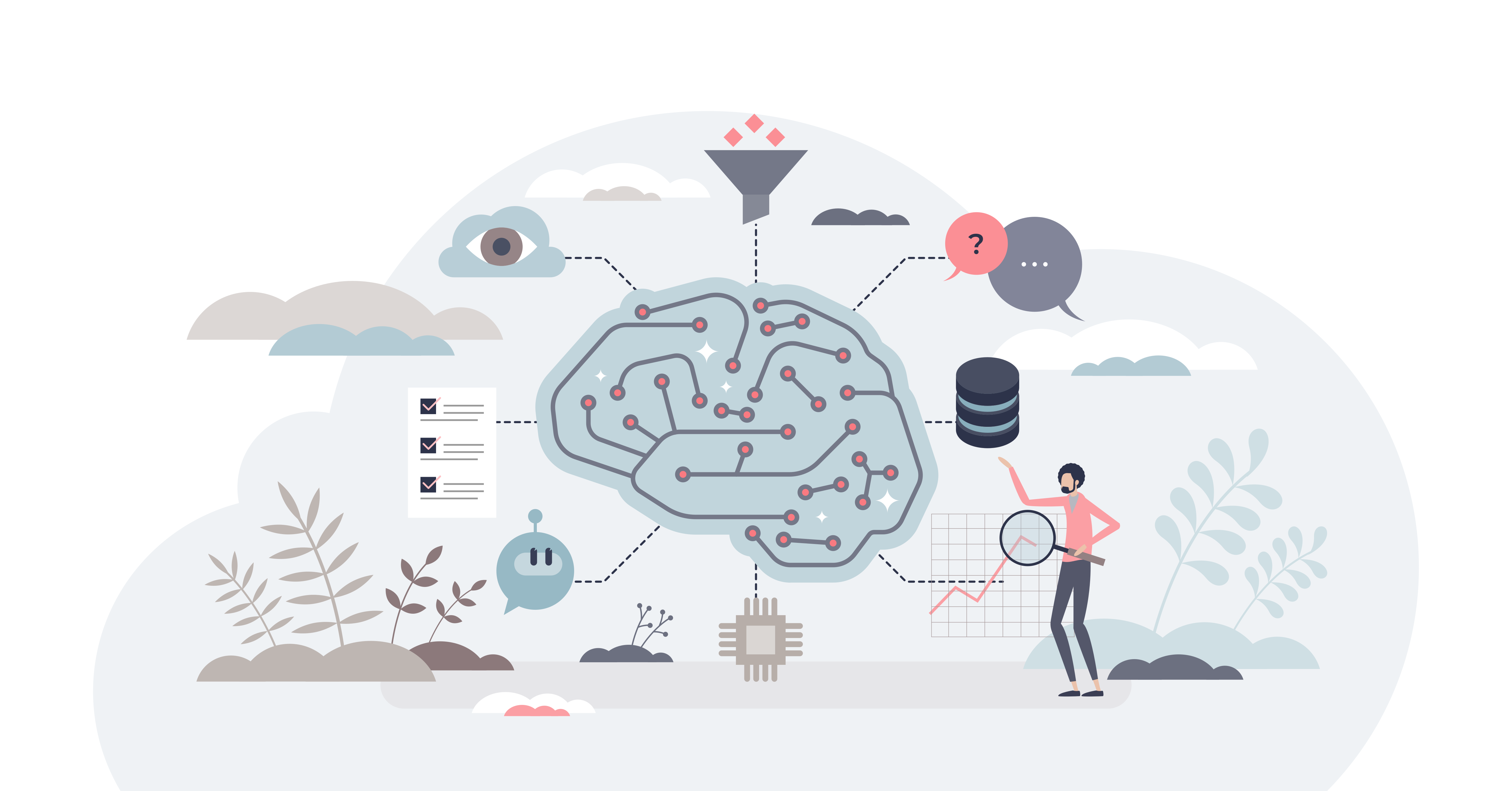In today's world, understanding data is like having a superpower for making smart choices in business.
Especially digital marketing field, using data and AI together is becoming super important for businesses to grow and stay competitive. The future belongs to those who can use data and AI to make better decisions and achieve success they can count on.
In this blog, we will focus on:
- Why Data Analysis Matters?
- What Are the Four Pillars of Data Analysis with AI?
- The Future of Data Analysis with AI
1. Why Data Analysis Matters?
In today's data-driven world, the ability to effectively analyze data is crucial for businesses and organizations to make informed decisions.
Data analysis empowers companies to uncover valuable insights, identify trends, and anticipate future outcomes, enabling them to stay competitive and agile in rapidly evolving markets.
Whether it's understanding customer behavior, optimizing operations, or predicting market trends, harnessing the power of data analysis can drive innovation, improve efficiency, and ultimately, drive success.
In summary, data analysis plays a pivotal role in empowering businesses to:
- Understand Customers: By examining data from customer interactions, businesses can get a clear picture of what their customers want and don't want.
- Create Personalized Strategies: With the right data, marketers can make personalized campaigns that meet individual customer needs, boosting engagement and loyalty.
- Predict Trends: Data analysis can forecast market changes, helping businesses stay ahead of the game.
- Make Better Decisions: Decisions based on solid data are more accurate and strategic, reducing the risk of expensive errors.
- Increase Efficiency & Innovation: Data analysis can point out trends and inefficiencies, improving campaigns and business performance.
For example, imagine a retail company aiming to enhance its marketing strategy.
By leveraging data analysis, the company can analyze customer purchasing patterns, demographic information, and social media engagement to tailor personalized marketing campaigns.
Through this analysis, they can identify the most effective channels, optimal timing, and relevant messaging to target specific customer segments.
This targeted approach not only increases the likelihood of conversions but also strengthens customer relationships and loyalty.
Ultimately, data analysis enables the company to allocate resources efficiently, maximize ROI, and stay ahead in a competitive market.
2. What Are the Four Pillars of Data Analysis with AI?
There are four important ways to look at data—Descriptive (looking at the past), Diagnostic (figuring out why things happen), Predictive (guessing what might happen next), and Prescriptive (suggesting what to do).
Today, innovations like AI Scope are transforming the way we leverage computers to gain deeper insights from data.

Understanding data involves looking at it from different angles. The four pillars of data analysis are like four tools that help businesses make sense of information:
A) Descriptive Analysis
Descriptive analysis serves as the historical compass for businesses, providing a detailed summary of past events and occurrences.
Companies across various industries utilize this pillar to gain insights into trends, patterns, and performance metrics that have shaped their operations.
For instance, an e-commerce platform may leverage descriptive analysis to identify the best-selling products of the previous quarter, enabling it to optimize inventory, marketing strategies, and customer experiences. Or, a healthcare organization can seek to understand patient demographics and healthcare utilization patterns within a specific region.
By conducting descriptive analysis of their patient data, the organization can generate insights into factors such as age distribution, prevalent medical conditions, frequency of visits, and preferred services.
This information helps healthcare providers better allocate resources, optimize staffing levels, and tailor services to meet the needs of their patient population.
The technical implementation of descriptive analysis involves data organization, statistical calculations, and visualization tools.
During data organization, raw data is structured and prepared for analysis; statistical calculations uncover patterns and summarize key metrics; visualization tools transform the analyzed data into meaningful charts, graphs, or dashboards for easier interpretation.
When this information is used with AI, AI algorithms process historical data to generate summaries and visual representations. Some notable users of descriptive analysis include retail giants like Amazon and Walmart, who meticulously study past sales data to streamline their product offerings and enhance customer satisfaction.
In the realm of online content, media organizations employ descriptive analysis to gauge audience engagement, identifying popular topics or content formats to tailor their future productions accordingly.
B) Diagnostic Analysis
When faced with a decline in performance or unexpected outcomes, diagnostic analysis steps in as the investigative tool, unraveling the 'why' behind the 'what.'
Businesses deploy this pillar to identify root causes and factors contributing to deviations from expected results.
For instance, if an e-commerce platform experiences a sudden drop in sales, it can deep dive into various factors such as website traffic, conversion rates, and customer feedback to identify the root cause of the decline through diagnostic analysis.
By pinpointing issues such as technical glitches, ineffective marketing campaigns, or product quality concerns, the company can implement targeted solutions to address the underlying problems and restore sales performance.
Technically, diagnostic analysis involves techniques like root cause analysis and regression analysis.
During root cause analysis, the underlying factors contributing to a specific outcome or problem are identified, while regression analysis assesses the relationship between variables to determine potential causes or predictors
With the help of AI advanced algorithms, data can be dissected to identify patterns and relationships, helping businesses understand the intricacies of their operational challenges.
Tech giants like Google and Facebook employ diagnostic analysis to continually refine their algorithms and advertising strategies based on user behavior and feedback. This iterative approach allows them to continually optimize their services and maintain a competitive edge.
C) Predictive Analysis
Predictive analysis shifts the focus from the past to the future, leveraging historical data to make informed projections.
Businesses, especially those in the dynamic world of e-commerce, use predictive analysis to forecast future trends, demands, and potential outcomes.
For instance, an online store might estimate sales figures for the upcoming quarter, aiding in inventory management and resource planning. Or, let us say a financial institution is aiming to reduce credit card fraud. Through predictive analysis, the institution can analyze historical transaction data, customer behaviors, and fraud patterns to develop predictive models.
These models can then be used to identify suspicious transactions in real-time, enabling the institution to proactively prevent fraudulent activities and protect its customers' financial assets.
The technical implementation of predictive analysis involves the use of machine learning algorithms and statistical modeling.
In data preprocessing, raw data is cleaned, transformed, and prepared for analysis; feature selection identifies the most relevant variables for predictive modeling.
Model training involves feeding the prepared data into machine learning algorithms or statistical models to learn patterns and relationships.
Model evaluation assesses the performance of the trained model using validation techniques such as cross-validation or holdout sets and finally, model deployment involves integrating the trained model into the production environment for real-time predictions or decision-making.
These algorithms analyze historical data to identify patterns, which are then applied to new data for forecasting.
E-commerce giants such as Alibaba and eBay utilize predictive analysis to optimize supply chains, ensuring timely delivery of products based on anticipated demand.
By harnessing machine learning algorithms, these companies can adapt swiftly to market shifts and capitalize on emerging opportunities.
D) Prescriptive Analysis
The pinnacle of data analysis, prescriptive analysis not only predicts future scenarios but also provides actionable recommendations.
This advanced tool is instrumental in strategic decision-making, guiding businesses on the most effective actions to maximize desired outcomes.
For example, an e-commerce platform may use prescriptive analysis to optimize stock levels based on predicted demand, ensuring optimal inventory turnover. Or, imagine a transportation company seeking to optimize its delivery routes for efficiency and cost-effectiveness.
Through prescriptive analysis, the company can analyze factors such as traffic patterns, vehicle capacities, delivery deadlines, and fuel costs to generate optimal route recommendations. These recommendations can then be used to guide drivers in real-time, minimizing fuel consumption, reducing delivery times, and maximizing overall fleet efficiency.
Technically, prescriptive analysis delves into the intricate realm of sophisticated algorithms such as genetic algorithms, linear programming, and evolutionary algorithms, along with advanced optimization techniques like simulated annealing and swarm intelligence.
These algorithms navigate through vast datasets, meticulously considering not only historical data but also intricate business constraints and multifaceted objectives.
By incorporating these cutting-edge computational methods, prescriptive analysis goes beyond traditional predictive models, providing nuanced recommendations that align with the intricacies of a business's operational landscape.
In the realm of online content, media organizations leverage prescriptive analysis to enhance user experience.
Streaming services like Netflix use viewer behavior data to recommend personalized content, keeping users engaged and satisfied. The integration of artificial intelligence and analytics in these platforms ensures continuous refinement of recommendations, aligning content offerings with user preferences.
3. The Future of Data Analysis with AI

Data analysis is now and the future, and it's getting even more exciting with AI.
Here's why:
- Automated Collection: AI algorithms can scout through various sources to gather data faster and more accurately than manual methods. They ensure a steady stream of diverse, relevant information.
- Enhanced Accuracy in Cleansing: AI-powered tools excel in identifying and rectifying errors or inconsistencies within datasets. They streamline the process of removing duplicates, filling in missing values, and standardizing formats, ensuring cleaner data for analysis.
- Speed and Scalability: AI-powered systems can process large datasets at lightning speed. They quickly sort, organize, and structure data for easier analysis, saving considerable time and resources.
- Pattern Recognition: AI algorithms excel in recognizing patterns and correlations within datasets that might be too complex or numerous for manual analysis. This allows for deeper insights and more robust decision-making.
- Advanced Analytics: AI-driven analytics tools employ machine learning algorithms to uncover hidden trends, outliers, and predictive patterns. This enables businesses to glean insights that might otherwise remain unnoticed.
- Personalized Recommendations: AI models analyze data to offer personalized recommendations or predictions. They help in understanding customer behaviors, market trends, and future possibilities, aiding in informed decision-making.
- Predictive Modeling: AI's predictive capabilities assist in forecasting future trends and outcomes based on historical data. This aids in developing proactive strategies that anticipate changes and adapt to market shifts.
- Optimization and Adaptation: AI continuously learns from new data, allowing strategies to evolve and adapt in real-time. This adaptive approach helps in optimizing processes, marketing efforts, and resource allocation.
AI revolutionizes every stage of data analysis. From efficient data collection and cleansing to processing, generating insights, and strategy development, AI's capabilities enhance accuracy, speed up processes, unveil hidden patterns, and empower businesses to make informed decisions in an ever-evolving landscape.
The future is for those who not only know data's value but can also use it effectively. As NMQ Digital, we are ready to be your trusted partner through this journey with its Data & Analytics Services.






